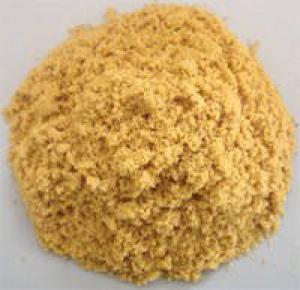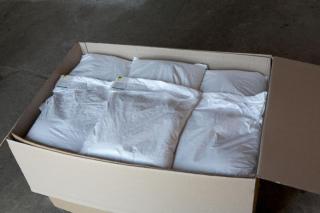Sunflower Lecithin
Lecithin - vegetable matter having strong surfactant properties is frequently used as a food additive emulsifier. Its name comes from the Greek word lekithos - egg yolk, which is a rich source of lecithin.
Commercial lecithin is obtained mainly from the refining of soya or sunflower oil. Lecithin is a complex mixture containing 65-75% phospholipids and triglycerides with a small amounts of other substances. The main phospholipids contained in lecithin is soy phosphatidylcholine (19-21%), phosphatidylethanolamine (8-20%), inositol-containing phosphatides (20-21%) and phosphatidylserine (5.9%). In addition, lecithin commonly contain soybean or sunflower oil (33-35%), free fatty acids, esters, tocopherols, biological pigments, sterins and sterols (2-5%), carbohydrate (5%).
 Sometimes the term "lecithin" is used synonymously to the term phospholipids.
Sometimes the term "lecithin" is used synonymously to the term phospholipids.
Appearance: yellowish-brown powder with a faint characteristic odor. Easy lumping.
Lecithin is an essential component of cell structure that actively participate in the metabolism of cells. This is a necessary substrate for the construction of cellular membranes ensuring transfer of ions and molecules across biological membranes. Lecithin is a necessary ingredient for the body. Lecithin comprises 50% of the liver, 1/3 brain insulating and protecting the tissues surrounding the brain and spinal cord. Lecithin is necessary for the organism as a building material for the renovation of damaged cells. He plays a key role in ensuring the full functioning of the brain and nervous system.
Lecithin - a primary vehicle for delivery of nutrients, vitamins and drugs to cells. With a deficit of lecithin the effectiveness of the impact of drugs reduces.
Lecithin is a powerful antioxidant that prevents the formation of highly toxic free radicals in the body.
Lecithin widely used in the food industry as a food additive (E-322). In the food industry emulsifying properties of lecithin are used in the production of margarines, soluble vegetable and dairy products, ready-to-use glazes. Lubricant and release properties of lecithin are used in products such as fats for frying and coating spray. Lecithin is also used to change the viscosity of chocolate products, and various types of glazes. Lecithin may also be used in the food industry as an antioxidant (a substance that prevents oxidation). In the role of lecithin used as an antioxidant agent. Lecithin is a surface-active agent - it works well at the interface of different substances. In the presence of two immiscible liquid phases, lecithin lowers the surface tension and acts as an emulsifier. When necessary interaction between the solid and the liquid phase, the lecithin acts as a wetting and dispersing agent. When used between solid phases, the substance acts as a lubricant. Lecithin also works well as a release agent from the mold (reduces the adherence of the forms).
In the bakery production the use of lecithin leads to improving of dough machinability, better volume and increasing shelf life.
Lecithin stops moisture and minimizes wafers crumbling, giving them a nice texture, color and natural crunch.
In the production of crackers, cookies, cakes and pies use of lecithin improves the properties of shortening and acts as a mold release agent.
Lecithin dissolves well in the dough and it allows you to adjust the consistency. The emulsifying properties of the powder simplify machining of the dough by giving it the necessary dryness. The result of the use of lecithin is a significant decrease in the percentage of defective products.
Besides of the above, lecithin can replace egg lecithins if their use is provided by cooking recipe. Lecithin not only become a full-fledged alternative to the eggs, but also improve dough characteristics such as layering and structure.
 The use of lecithin in confectionery gives to dough strength, to its color - uniformity and to texture and structure - smoothness. Another ability of lecithin: to give the finished product a steady color and reduce the risk of cracking.
The use of lecithin in confectionery gives to dough strength, to its color - uniformity and to texture and structure - smoothness. Another ability of lecithin: to give the finished product a steady color and reduce the risk of cracking.
In the production of biscuits due to lecithin dough is formed elastic. Cookies prepared with the help of lecithin become crisp, so that it is possible even to reduce the fat content. Sunflower lecithin allows to reduce the fats need for about 20 - 25% in cookies or any other product. Moreover, lecithin slow down fat oxidation so cookies remain fresh longer.
Sunflower Lecithin also helps to form a thin film around the particles of yeast in frozen pizza, thereby protecting the product from shock freezing and damage.
Approximate dosage lecithin: from 0.5% to 2% by weight of the flour.
In the non-food applications the lecithin commonly used in body paint and solvents, vinyl flooring and cosmetics. Other applications - paper processing, production of ink, fertilizers, explosives, pesticides.
For many years it is studing the use of lecithin in the cosmetic industry. However, due to loss of stability and the tendency to oxidize when exposed to high temperatures the use of lecithin in cosmetics is limited. This is true for soy and egg lecithin but sunflower lecithin is the most stable.
Its meaning for the cells, in particular, damaged and aging, can not be overestimated. Lecithin has a direct membranotropic effect by direct incorporation into phospholipid structure of damaged cell membranes by restoring impaired barrier function of the lipid bilayer. Essential fatty acids are vegetable phospholipids promote increased activity and membrane fluidity participate in the inhibition of lipid peroxidation, increase the activity of cellular enzymes are precursors of many biologically active compounds.
Lecithin in the composition of cosmetic products (1-3%) is absorbed quickly and provides skin softening and toning effect. Due surface active properties of lecithin it promotes fat deeper penetration, including biologically active substances in the epidermis. There is evidence of antioxidant properties of lecithin.
The phospholipids contained in lecithin attract water from the air, whereby it promotes moisturizing of the skin. This makes it a perfect ingredient for reducing creams, as well as funds intended for mature and dry skin.
As lecithin has emulsifying, stabilizing and thickening properties.
Cosmetic properties:
• excellent emulsifying agent;
• promotes penetration into the skin of other active ingredients;
• reduces irritation;
• well-dispersed pigments;
• soluble in water and in oil at room temperature;
• stabilizes the direct emulsion due to the formation of lamellar structures.
Due to the high penetrating power, lecithin promotes penetration into the skin of other active ingredients that effectively increases the effectiveness of the synergistic action of the components. This greatly increases the hydration of the skin and reduces its roughness and abrasions. Furthermore, it eliminates the irritation caused by other components.
 Lecithin can be used as a natural component to uniformly disperse various additives, preventing their accumulation and clumping. It provides stable emulsion.
Lecithin can be used as a natural component to uniformly disperse various additives, preventing their accumulation and clumping. It provides stable emulsion.
Applications: Drugs used in cosmetics for skin care, as an active agent and an emulsifier - up to 10%.
In the cosmetics industry, lecithin is increasingly used as BAS, adding it even in those emulsions that use other emulsifiers.
It is used for the production of moisturizing, revitalizing and toning creams, shampoos, conditioners, shaving creams, lip balms, lipsticks and many other products.
Dosage in cosmetics: lecithin is difilen, so it can be added as the aqueous and the oil phase.
For the convenience of using put lecithin in water and heat. While dissolving in hot water forms lumps. The recommended temperature for emulsification - 60-70 ° C (for use as an emulsifier or coemulsifier using a mixer or homogenizer).
The amount of lecithin depends on the desired consistency of the final product. Usually - 2-10%.
